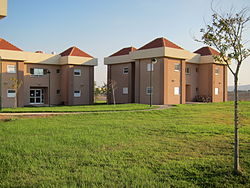Ein HaNetziv
Ein Hanatziv | |
|---|---|
 | |
| Coordinates: 32°28′13″N 35°30′9″E / 32.47028°N 35.50250°E | |
| Country | Israel |
| District | Northern |
| Council | Valley of Springs |
| Affiliation | Religious Kibbutz Movement |
| Founded | 1946 |
| Founded by | Bnei Akiva members |
| Population (2022) | 641[1] |
| Website | http://www.hanatziv.org.il/ |
Ein Hanatziv (Hebrew: עֵין הַנְּצִי"ב, lit. Spring of the Netziv) is a kibbutz in the Beit She'an Valley in northern Israel. Belonging to the Religious Kibbutz Movement, it is located about three kilometers south of the ancient city of Beit She'an, 130 meters below sea level. It falls under the jurisdiction of Valley of Springs Regional Council. In 2022 it had a population of 641.[1]
Etymology
[edit]The name, translating to "Spring of (the) Netziv", comes from the springs found here, plus the initials of Rabbi Naftali Zvi Yehuda Berlin, the "Netziv of Volozhin" (1816 – 1893), who was one of the greatest rabbis of Russia at the end of the 19th century.
History
[edit]


The kibbutz was established on 17 January 1946 on a site known in Arabic as "el-Wakwaka" by a group of young people of the Bnei Akiva Movement from Germany.
In the late 1960s, while preparing the lands for cultivation, members of the kibbutz discovered the Mosaic of Rehob among the ruins of an ancient synagogue.
Economy
[edit]The economy of the village today is based on agriculture (a herd of about a thousand cattle, extensive orchards of date palms and olive trees, cereal crops) and a plastics factory, Palziv, which exports all over the world.[2]
Education
[edit]Within the kibbutz there are several educational establishments. The Religious Kibbutz Movement's religious seminary for young women (Midreshet Kibbutz HaDati / מדרשת עין הנצי"ב) offers several programs:[3] Torah study pre- and post sherut leumi; similar integration with military service; an overseas program; intensive training for "instructors in halakha" (Jewish law). The kibbutz also hosts an intensive study course or "ulpan" for French speakers wishing to convert to Judaism, which offers Hebrew language and Orthodox Judaism classes.[2][4]
References
[edit]- ^ a b "Regional Statistics". Israel Central Bureau of Statistics. Retrieved 21 March 2024.
- ^ a b Conversion ulpan programs Archived 2009-12-08 at the Wayback Machine Religious Kibbutz Movement
- ^ Site of the midrasha
- ^ "Oulpan de Conversion au Kibboutz ein Hanatziv". 11 June 2014. Archived from the original on 29 May 2017. Retrieved 25 May 2017.

